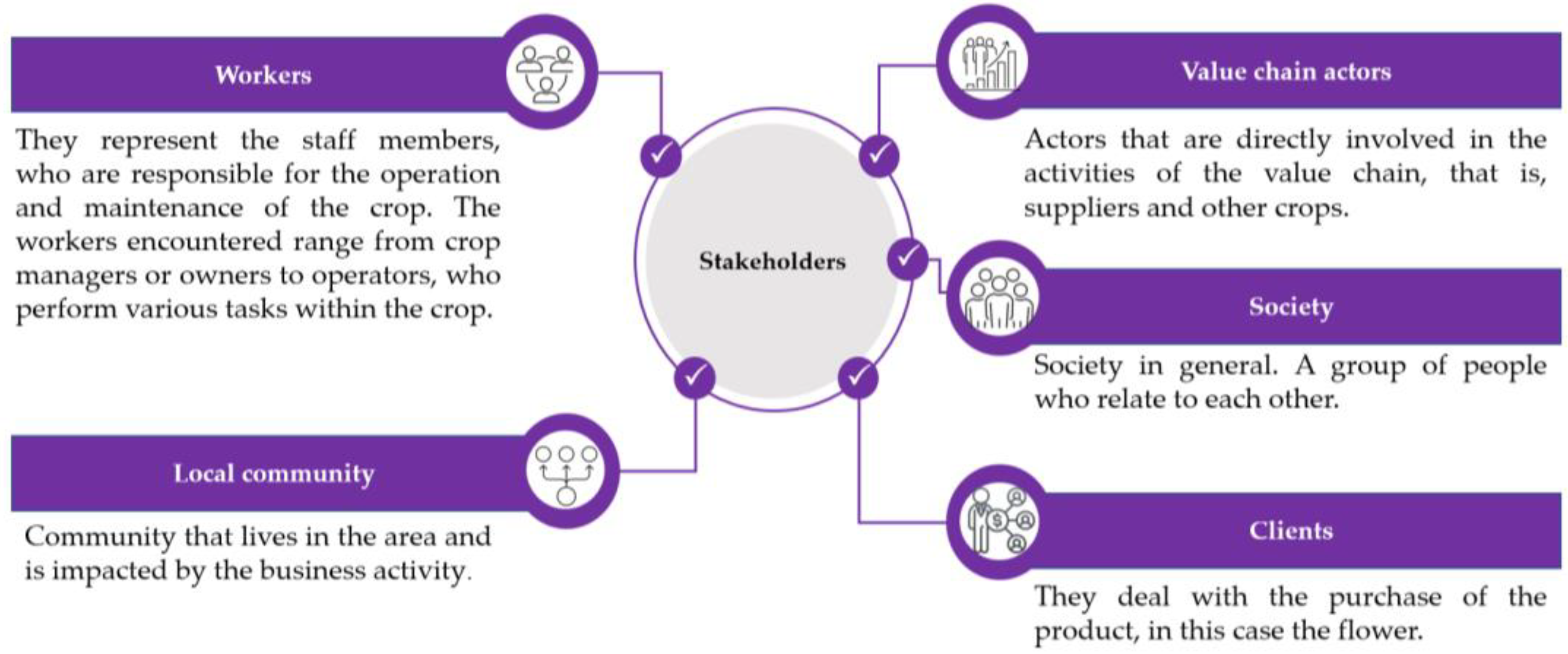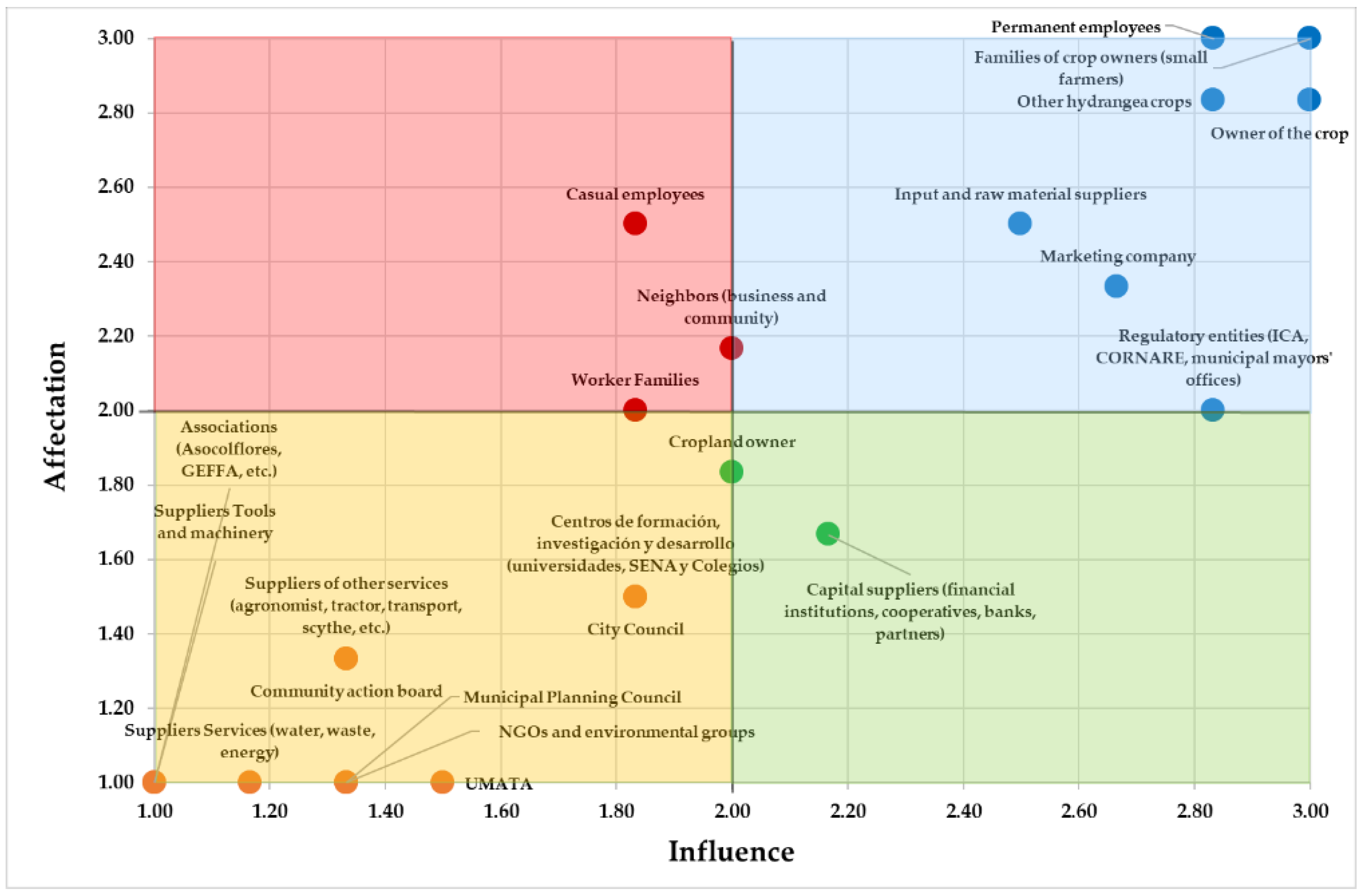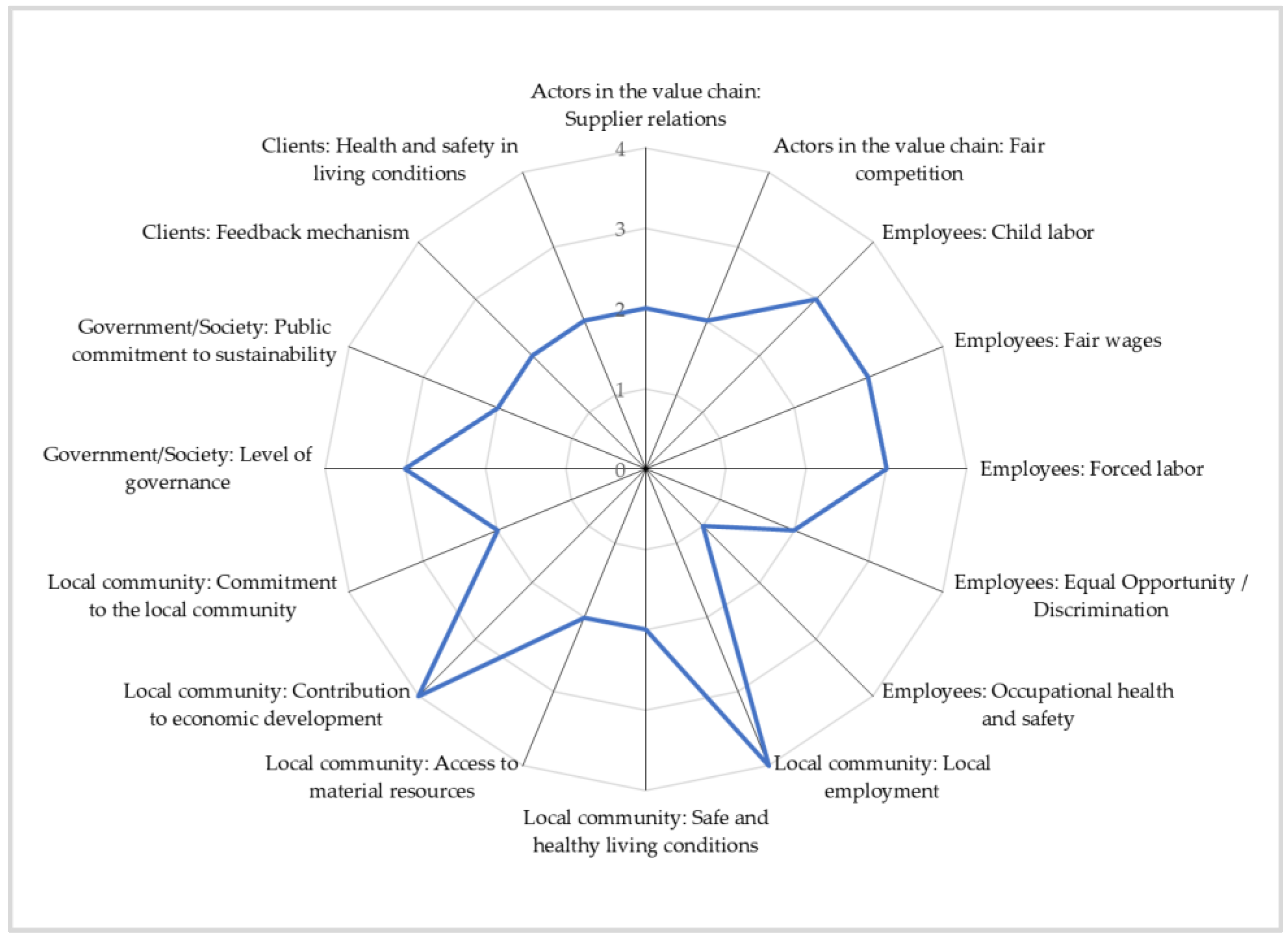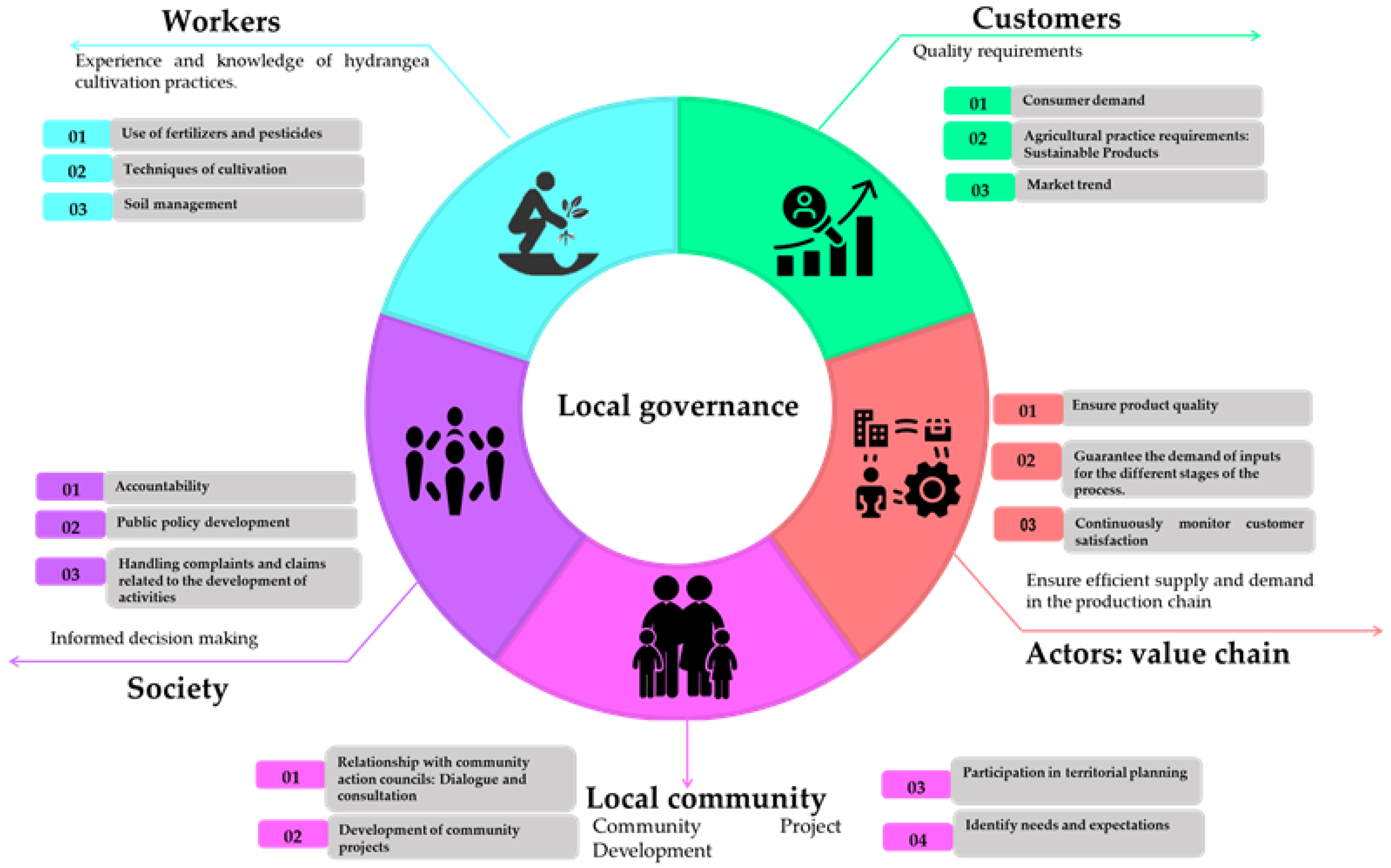A Social Life Cycle Assessment as a Key to Territorial Development: A Study of the Hydrangea Crop in Colombia
Abstract
1. Introduction
2. Literature Review
3. Materials and Methods
3.1. The Province of La Paz
3.2. Hydrangea Production
3.3. Goal and Scope Definition
3.4. Identification of Stakeholders
3.5. Prioritization of Stakeholders
- -
- The influence variable: Does the stakeholder have a large influence on the cultivation and marketing of hydrangeas?
- -
- The influence variable: Does the interest group have a strong influence on the cultivation and marketing of hydrangeas?
- -
- The future variable: Will the stakeholder be highly influential or highly affected in the future?
Selection of Indicators
3.6. Impact Assessment Method
3.7. Stakeholders and Their Participation in Local Governance
4. Results
4.1. Prioritized Stakeholders
4.1.1. Workers
4.1.2. Local Community
4.1.3. Society
4.1.4. Consumers
4.1.5. Value Chain Actors
4.2. Indicators for Prioritized Stakeholders
5. Discussion
5.1. Social Life Cycle Impact Assessment
5.2. Stakeholders and Their Participation in Local Governance
5.3. Relationship with Sustainable Development Goals
6. Conclusions
Author Contributions
Funding
Institutional Review Board Statement
Informed Consent Statement
Data Availability Statement
Acknowledgments
Conflicts of Interest
References
- Hernández, N. Implementación del Clústeres: Una Estrategia Para Aumentar la Competitividad en la Industria Floricultura Colombiana 2000–2018; Fundación Universidad de América: Bogotá D.C., Colombia, 2021. [Google Scholar]
- Vega, J.P. Un Buen Ejemplo de la Economía Naranja es la Floricultura”: Asocolflores. 2018. Retrieved 26 June 2023. 2018. Available online: https://www.larepublica.co/economia/un-buen-ejemplo-de-la-economia-naranja-es-la-floricultura-asocolflores-2781728 (accessed on 24 October 2023).
- Ministerio de Comercio, Industria y Turismo. Noticia de Comercio. Exportaciones de Bienes no Minero Energéticos Alcanzaron Valor Más Alto Para un Primer Semestre Desde 2013. 2021. Available online: https://www.mincit.gov.co/prensa/noticias/comercio/exportaciones-bienes-no-minero-energeticos-crece (accessed on 26 June 2023).
- Gómez, C.E.; García, C.E. Floriculturas en el Oriente Antioqueño; Escuela Nacional Sindical: Medellín, Colombia, 2007; pp. 19–222. [Google Scholar]
- Orientese. Provincia de la Paz Empieza. 2021. Available online: https://orienteseperiodismodeopinion.com/provincia-de-la-paz (accessed on 5 July 2023).
- Zuluaga, J.F. Transformación del Espacio Floricultor: Un Territorio de la Globalización en el Cercano Oriente de Antioquia; Universidad de Antioquia: Medellín, Colombia, 2020. [Google Scholar]
- United Nations Environment Programme (UNEP). Guidelines for Social Life Cycle Assessment (S-LCA) of Products and Organizations 2020; UNEP: Nairobi, Kenya, 2020. [Google Scholar]
- ISO 14040:2007; Environmental Management—Life Cycle Assessment. Principles and Framework. ISO: Geneva, Switzerland, 2007.
- ISO 14044:2006; Environmental Management—Life Cycle Assessment—Requirements and Guidelines. International Standard Organisation: Geneva, Switzerland, 2006.
- Finkbeiner, M.; Inaba, A.; Tan, R.; Tan, R.; Christiansen, K.; Jürge, H. The New International Standards for Life Cycle Assessment: ISO 14040 and ISO 14044. Int. J. Life Cycle Assess. 2006, 11, 80–85. [Google Scholar] [CrossRef]
- Prasara, A.J.; Gheewala, S. An assessment of social sustainability of sugarcane and cassava cultivation in Thailand. Sustain. Prod. Consum. 2021, 27, 372–382. [Google Scholar] [CrossRef]
- Toniolo, S.; Tosato, R.C.; Gambaro, F.; Ren, J. Life cycle thinking tools: Life cycle assessment, life cycle costing and social life cycle assessment. In Life Cycle Sustainability Assessment for Decision-Making: Methodologies and Case Studies; Elsevier: Amsterdam, The Netherlands, 2020; pp. 39–56. [Google Scholar] [CrossRef]
- Yang, S.; Ma, K.; Liu, Z.; Ren, J.; Man, Y. Development and applicability of life cycle impact assessment methodologies. In Life Cycle Sustainability Assessment for Decision-Making: Methodologies and Case Studies; Elsevier: Amsterdam, The Netherlands, 2020; pp. 95–124. [Google Scholar] [CrossRef]
- Peruzzini, M.; Gragori, F.; Luzi, A.; Mengarelli, M.; Germani, M. A social life cycle assessment methodology for smart manufacturing: The case of study of a kitchen sink. J. Ind. Inf. Integ. 2017, 7, 24–32. [Google Scholar] [CrossRef]
- Petti, L.; Serreli, M.; Si Cesare, S. Systematic literature review in social life cycle assessment. Int. J. Life Cycle Assess. 2018, 23, 422–431. [Google Scholar] [CrossRef]
- Franze, J.; Ciroth, A. A comparison of cut roses from Ecuador and the Netherlands. Int. J. Life Cycle Assess. 2011, 16, 366–379. [Google Scholar] [CrossRef]
- Manik, Y.; Leahy, J.; Halog, A. Social life cycle assessment of palm oil biodiesel: A case study in Jambi Province of Indonesia. Int. J. Life Cycle Assess. 2013, 18, 1386–1392. [Google Scholar] [CrossRef]
- Martínez-Blanco, J.; Lehmann, A.; Muñoz, P.; Antón, A.; Traverso, M.; Rieradevall, J. Application challenges for the social Life Cycle Assessment of fertilizers within life cycle sustainability assessment. J. Clean. Prod. 2014, 69, 34–48. [Google Scholar] [CrossRef]
- Arcesea, G.; Lucchetti, M.C.; Massa, I. Modeling Social Life Cycle Assessment framework for the Italian wine sector. J. Clean. Prod. 2017, 140, 1027–1036. [Google Scholar] [CrossRef]
- Batista, R.; Gonçalves, V.; Passuello, A. Sustainability assessment of soybean production in Southern Brazil: A life cycle approach. Sustain. Prod. Consum. 2018, 13, 102–112. [Google Scholar]
- Siebert, A.; Bezama, A.; O’Keffe, S.; Thräm, D. Social life cycle assessment indices and indicators to monitor the social implications of wood-based products. J. Clean. Prod. 2018, 172, 4074–4084. [Google Scholar] [CrossRef]
- Haryati, Z.; Subramaniam, V.; Noor, Z.Z.; Hashim, Z.; Loh, S.; Aziz, A.A. Social life cycle assessment of crude palm oil production in Malaysia. Sustain. Prod. Consum. 2022, 29, 90–99. [Google Scholar] [CrossRef]
- Ramirez, O.K.; Petti, L.; Haberland, N.T.; Ugaya, C.M.L. Subcategory assessment method for social life cycle assessm Part 1: Methodological framework. Int. J. Life Cycle Assess. 2014, 19, 1515–1523. [Google Scholar] [CrossRef]
- Freeman, R.E. Strategic Management: A Stakeholder Approach; Cambridge University Press: Cambridge, UK, 2010. [Google Scholar]
- Krick, T.; Forstater, M.; Monaghan, P.; Sillanpää, M. De las Palabras a la Acción. El Compromiso con los Stakeholders. Manual para la Práctica de las Relaciones con los Grupos de Interés; Stakeholder Research Associates Canada Inc.: Toronto, ON, Canada, 2006; pp. 9–119. [Google Scholar]
- Bouillass, G.; Blanc, I.; Perez-Lopez, P. Step-by-step social life cycle assessment framework: A participatory approach for the identification and prioritization of impact subcategories applied to mobility scenarios. Int. J. Life Cycle Assess. 2021, 26, 2408–2435. [Google Scholar] [CrossRef]
- Life Cycle Initiative; UNEP; SETAC. Towards a Life Cycle Sustainability Assessment: Making Informed Choices on Products; UNEP DTIE–Sustainable Consumption and Production Branch: Paris, France, 2013. [Google Scholar]
- Global Reporting Initiative (GRI). Sustainability Reporting Guidelines; G4. Global Reporting Initiative: Amsterdam, The Netherlands, 2013. [Google Scholar]
- Pérez-Hernández, L.; Caballer-Miedes, A. Alianzas y asociatividad para el logro de los ODS en El Salvador: Una perspectiva desde los gobiernos locales. RIEM 2022, 25, 1–23. [Google Scholar] [CrossRef]
- Gouveia, I.R.; Lima, C.; Carvalho, L.; Kaiser, C.C.; Guimaraes, A.G. Evidence of risks of renal function reduction due to occupational exposure to agrochemicals: A systematic review. Environ. Toxicol. Phar. 2018, 63, 21–28. [Google Scholar]
- Dhananjayan, V.; Ravichandra, B. Occupational health risk of farmers exponsed to pesticides in agricultural activities. Curr. Opin. Environ. Sci. Health 2018, 4, 31–37. [Google Scholar] [CrossRef]
- Jaquet, S.; Kohler, T.; Schwilch, G. Labour Migration in the Middle Hills of Nepal: Consequences on Land Management Strategies. Sustainability 2019, 11, 1349. [Google Scholar] [CrossRef]
- Graeub, B.E.; Chappell, M.J.; Wittman, H.; Ledermann, S.; Kerr, R.; Gemmill-Herren, B. The state of family farms in the world. World Dev. 2016, 87, 1–15. [Google Scholar] [CrossRef]
- Plana-Farran, M.; Gallizo, J.L. The Survival of Family Farms: Socioemotional Wealth (SEW) and Factors Affecting Intention to Continue the Business. Agriculture 2021, 11, 520. [Google Scholar] [CrossRef]
- Li, Y.; Zhu, Z.; Xu, P. Research on the green production motivation of new agricultural business entities: Benefit perception and environmental regulation. J. Environ. Public. Health. 2022, 2022, 9182725. [Google Scholar] [CrossRef] [PubMed]
- Abebe, G.; Bijman, J.; Royer, A. Are middlemen facilitators or barriers to improve smallholders’ welfare in rural economies? Empirical evidence from Ethiopia. J. Rural Stud. 2016, 43, 203–213. [Google Scholar] [CrossRef]
- Amare, M.; Mariara, J.; Oostendorp, R.; Pradham, M. The impact of smallholder farmers’ participation in avocado export markets on the labor market, farm yields, sales prices, and incomes in Kenya. Land Use Policy 2019, 88, 104168. [Google Scholar] [CrossRef]
- Pollok, L.; Spierling, S.; Endres, H.; Grote, U. Social life cycle assessments: A review on past development, advances and methodological challenges. Sustainability 2021, 13, 10286. [Google Scholar] [CrossRef]
- Akter, S.; Rutsaert, P.; Luis, J.; Htwe, N.; Su San, S.; Raharjo, B.; Pustika, A. Women’s empowerment and gender equity in agriculture: A different perspective from Southeast Asia. Food Policy 2017, 69, 270–279. [Google Scholar] [CrossRef]
- Colombia Co. En Floricultura, la respuesta es Colombia. s.f. Available online: https://www.colombia.co/pais-colombia/hechos/en-floricultura-la-respuesta-es-colombia-2/ (accessed on 5 July 2023).
- Gonzáles, X. Cultivo de Hortensias, un Negocio con Gran Potencial en el Oriente Antioqueño. 2019. Available online: https://www.agronegocios.co/agricultura/cultivo-de-hortensias-un-negocio-con-gran-potencial-en-el-oriente-antioqueno-2821240 (accessed on 25 August 2023).
- Instituto Colombiano Agropecuario (ICA). Por edio de la cual se establece los requisitos para obtener el Registro del lugar de Producción de flores o ramas cortadas de las especies ornamentales con destino a la exportación y para el registro de Exportador e importador de flores o ramas cortadas de las especies ornamentales. 2020. Miniagricultura, 26. Available online: https://www.ica.gov.co/getattachment/3d945075-7708-47ca-a930-d411a3b0214d/Por-la-cual-se-establecen-los-requisitos-para-obte.aspx (accessed on 8 September 2022).
- Sawaengsak, W.; Olsen, S.; Hauschild, M.; Gheewala, S. Development of a social impact assessment method and application to a case study of sugarcane, sugar, and ethanol in Thailand. Int. J. Life Cycle Assess. 2019, 24, 2054–2072. [Google Scholar] [CrossRef]
- Ayassamy, P.; Pellerin, R. Social Life-Cycle Assessment in the construction industry: A review of characteristics, limitations, and challenges of S-LCA through Case Studies. Sustainability 2023, 15, 14569. [Google Scholar] [CrossRef]
- Vitálišová, K.; Murray-Svidroňová, M.; Jakuš-Muthová, N. Stakeholder participation in local governance as a key to local strategic development. Cities 2021, 118, 103363. [Google Scholar] [CrossRef]
- Sachs, J. La Era del Desarrollo Sostenible: Nuestro Futuro Está en Juego: Incorporemos el Desarrollo Sostenible a la Agenda Política Mundial. 2015. DEUSTO, Nueva York. 2014. Available online: https://proassetspdlcom.cdnstatics2.com/usuaris/libros_contenido/arxius/31/30978_La_era_del_desarrollo_sostenible.pdf (accessed on 25 August 2023).
- FAO (Foof and Agriculture Organization of the United Nations); IFAD (International Fund for Agricultural Development). United Nations Decade of Family Farming 2019-2028. 2019. Global Action Plan. Rome. License: CC BY-NC-SA 3.0 IGO. Available online: https://openknowledge.fao.org/server/api/core/bitstreams/5479e317-17b9-428b-9963-ba88e681ff16/content (accessed on 26 August 2023).





| Rating | Influence | Affectation | Future |
|---|---|---|---|
| 1 | The group has no influence on the performance (economic, social, or environmental) of the hydrangea crop and marketing. | The performance (economic, social, or environmental) of the hydrangea crop and marketing does not affect the group. | The group has no influence on the future performance (economic, social, or environmental) of the hydrangea crop and marketing. The group will not be affected by the future performance (economic, social, and environmental) of the hydrangea crop and marketing. |
| 2 | The group influences the performance (economic, social, or environmental) of the hydrangea crop and marketing but does not affect decision making. | The performance (economic, social, or environmental) of the hydrangea crop and marketing affects the group but does not directly affect decision making. | The group influences the future performance (economic, social, and environmental) of the hydrangea crop and marketing but will not affect decision making. The group will be affected by the future performance (economic, social, and environmental) of the hydrangea crop and marketing but will not directly affect decision making. |
| 3 | The group influences the performance (economic, social, or environmental) of the hydrangea crop and marketing and directly affects decision making. | The performance (economic, social, or environmental) of the hydrangea crop and marketing directly affects the group and decision making. | The group will influence the future performance (economic, social, environmental) of the hydrangea crop and marketing and will affect decision making. The group will be affected by the future performance (economic, social, environmental) of the hydrangea crop and marketing and will directly affect decision making. |
| UNEP Category | Subcategory of Interest | Indicators with BR | Unit of Measure | Reference Standards and Conventions |
|---|---|---|---|---|
| Actors in the value chain | Relationship with suppliers | Pay suppliers on time | Yes/No | Code of conduct or standards |
| Absence of coercive communication with suppliers | Yes/No | |||
| Fair competition | Regulatory and national legislation | Yes/No | Evidence of fair competition and antitrust compliance | |
| Sector agreement | Yes/No | |||
| Employee awareness of the importance of fair competition compliance | Yes/No | |||
| Workers | Child labor | Children under the age of 15 who are working, under the local compulsory school age, and enrolled in school | Yes/No | Presence of and compliance with policies against child labor and evidence that it is not registered in the sector |
| Fair wages | Minimum wage by country | Yes/No | Compliance with the legal minimum monthly wage in Colombia | |
| Lowest paid worker vs. minimum wage | % | |||
| Regular and documented payment | Yes/No | |||
| Forced labor | Percentage of forced labor in the sector | % | Compliance with policy against forced labor | |
| Equal opportunity/discrimination | Ratio of base salary of men to women by employee category | Yes/No | Presence of and compliance with anti-discrimination systems | |
| Percentage of men and women employed in the sector | % | |||
| Percentage of employees by age group: under 30 years old, between 30 and 50 years old, older than 50 years old | % | |||
| Occupational health and safety | Appropriate general occupational safety measures are taken | Yes/No | Policy, guideline, or program that demonstrates good health and safety practices | |
| Preventive measures and emergency protocols are in place for exposure to pesticides and chemicals | Yes/No | Policy, guideline, or program that demonstrates good health and safety practices Compliance with ISO 45001:2018 | ||
| Existence of education, training, counseling, prevention, and risk control programs to assist workers, their families, or community members with respect to serious diseases | Yes/No | |||
| Worker access to non-occupational medical and health services | Yes/No | |||
| Local community | Local employment | Percentage of people hired locally | % | Evidence of employment opportunities for local residents |
| Percentage of spending on local suppliers | % | |||
| Safe and healthy living conditions | Management to minimize the use of hazardous substances | Yes/No | Ranking UNDP (United Nations Development Programme) | |
| Access to material resources | Risk assessment regarding the potential for material resource conflicts | Yes/No | Internal policy to ensure the care of natural resources | |
| Contribution to economic development | Percentage of GDP (Gross Domestic Product), number of employees relative to labor force, wage levels, etc. | % | Evidence of community economic development | |
| Contribution of the product/service/organization to economic progress | Yes/No | |||
| Commitment to the local community | Organizational support for community initiatives | Yes/No | Evidence that the company cares about the environment and the community | |
| Government/society | Level of governance | Government policies—land use | Yes/No | LMP (Land Management Plan) compliance |
| Land tenure security | Yes/No | |||
| Public commitment to sustainability | Sector commitment to sustainability (economic, social, and environmental) | Yes/No | Sustainability commitments and agreements | |
| Corruption risk in the sector | Yes/No | |||
| Customers | Health and safety in living conditions | Incidents of non-compliance with regulations and voluntary codes concerning the health and safety impacts of products and services during their life cycle—relationship with customers | Yes/No | Procedures to prevent violations of customer safety and health |
| Feedback mechanisms | Existence of a mechanism for customer feedback | Yes/No | Customer satisfaction practices and feedback mechanisms |
| Category UNEP | Stakeholder | Subcategory | Indicator | Result |
|---|---|---|---|---|
| Actors in the value chain | Suppliers’ inputs and raw materials | Supplier relations | Pay suppliers on time | Yes |
| Absence of coercive communication with suppliers | Yes | |||
| Other hydrangea crops | Fair competition | Regulatory and national legislation | Yes | |
| Sector agreement | No | |||
| Employee awareness of the importance of fair competition compliance | Yes | |||
| Employees | Permanent employees (PE) and crop owners | Child labor | Children under the age of 15 who are working, under the local compulsory school age, and in school | No |
| Fair wages | Minimum wage by country | Yes | ||
| Regular (periodic) and documented payment of workers (weekly, bi-weekly) | Yes | |||
| Forced labor | Percentage of forced labor in the sector | 20% | ||
| Equal opportunity/discrimination | Ratio of base salary of men to women by employee category | No | ||
| Percentage of men and women employed in the sector | PE: M:50% and W:50% CE: M:40% and W: 60% | |||
| Percentage of employees by age group: under 30 years old, between 30 and 50 years old, older than 50 years old | Between 30 and 50 years: PE: 100% and CE: 100% | |||
| Occupational health and safety | Appropriate general occupational safety measures are adopted | No | ||
| Preventive measures and emergency protocols are in place for exposure to pesticides and chemicals | Yes | |||
| Worker access to non-occupational medical and health services | Yes | |||
| Local community | Neighbors (business and community) | Local employment | Percentage of people hired locally | 100% |
| Percentage of spending on local suppliers | 100% | |||
| Safe and healthy living conditions | Management to minimize the use of hazardous substances | No | ||
| Access to material resources | Risk assessment regarding the potential for material resource conflicts | No | ||
| Contribution to economic development | Relevance of the sector under consideration to the (local) economy (percentage of GDP (Gross Domestic Product), number of employees in relation to the size of the working population, wage levels, etc.) | The sector contributes 7% to the national agricultural GDP. | ||
| Contribution of the product/service/organization to economic progress (sales, profits, wages paid, etc.) | Yes | |||
| Commitment to the local community | Organizational support for community initiatives | No | ||
| Government/society | Regulatory entities (ICA, CORNARE, municipal mayors’ offices) | Level of governance | Government policies—land use | Yes |
| Public commitment to sustainability | Sector commitment to sustainability (economic, social, and environmental) | No | ||
| Customers | Marketing company | Health and safety in living conditions | Incidents of non-compliance with regulations and voluntary codes concerning the health and safety impacts of products and services during their life cycle—relationship with customers | No |
| Feedback mechanism | Existence of a mechanism for customer feedback | No |
Disclaimer/Publisher’s Note: The statements, opinions and data contained in all publications are solely those of the individual author(s) and contributor(s) and not of MDPI and/or the editor(s). MDPI and/or the editor(s) disclaim responsibility for any injury to people or property resulting from any ideas, methods, instructions or products referred to in the content. |
© 2024 by the authors. Licensee MDPI, Basel, Switzerland. This article is an open access article distributed under the terms and conditions of the Creative Commons Attribution (CC BY) license (https://creativecommons.org/licenses/by/4.0/).
Share and Cite
Arenas, C.N.; Bello, A.P.; Molina, N.F.; Botero, J.L.; Betancur, M. A Social Life Cycle Assessment as a Key to Territorial Development: A Study of the Hydrangea Crop in Colombia. Sustainability 2024, 16, 4156. https://doi.org/10.3390/su16104156
Arenas CN, Bello AP, Molina NF, Botero JL, Betancur M. A Social Life Cycle Assessment as a Key to Territorial Development: A Study of the Hydrangea Crop in Colombia. Sustainability. 2024; 16(10):4156. https://doi.org/10.3390/su16104156
Chicago/Turabian StyleArenas, Cindy Natalia, Ana Patricia Bello, Nicolás Fernando Molina, Jaime León Botero, and Mariluz Betancur. 2024. "A Social Life Cycle Assessment as a Key to Territorial Development: A Study of the Hydrangea Crop in Colombia" Sustainability 16, no. 10: 4156. https://doi.org/10.3390/su16104156
APA StyleArenas, C. N., Bello, A. P., Molina, N. F., Botero, J. L., & Betancur, M. (2024). A Social Life Cycle Assessment as a Key to Territorial Development: A Study of the Hydrangea Crop in Colombia. Sustainability, 16(10), 4156. https://doi.org/10.3390/su16104156






